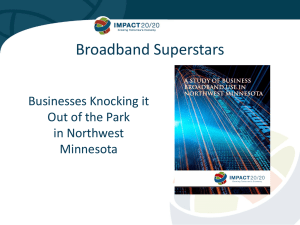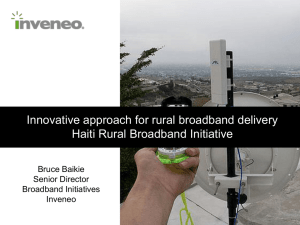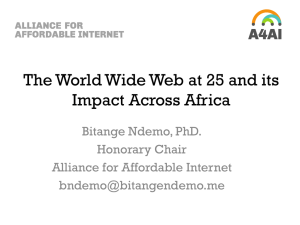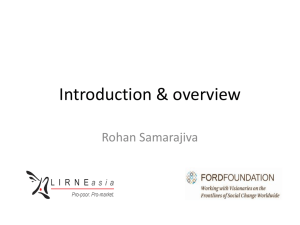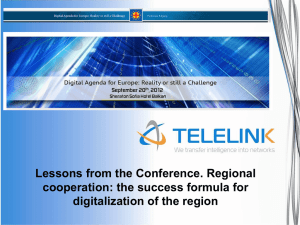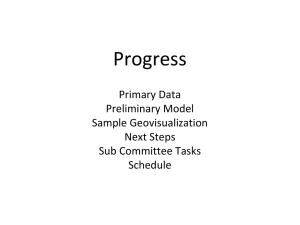National broadband and ICT strategies Some observations
advertisement
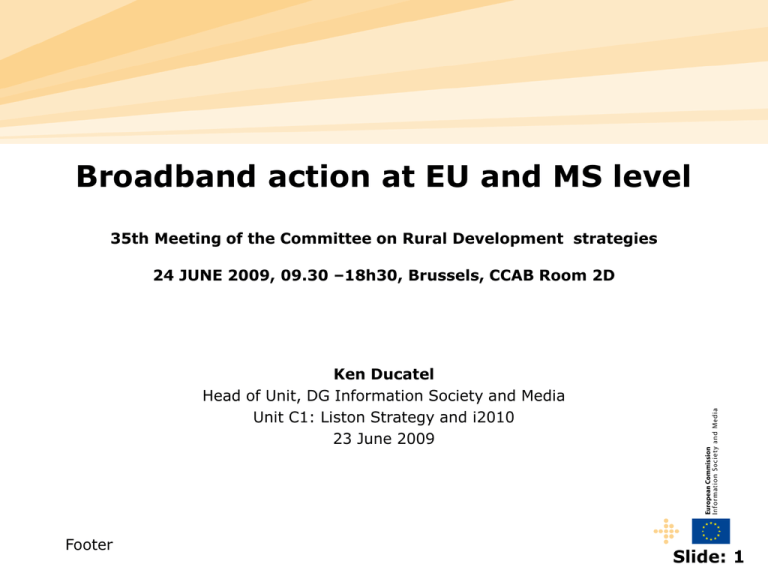
Broadband action at EU and MS level 35th Meeting of the Committee on Rural Development strategies 24 JUNE 2009, 09.30 –18h30, Brussels, CCAB Room 2D Ken Ducatel Head of Unit, DG Information Society and Media Unit C1: Liston Strategy and i2010 23 June 2009 Footer Slide: 1 Forthcoming EU Broadband strategy Main themes • Trigger investment in new high-speed fibre networks Need to ensure a high speed, good quality broadband infrastructure with good download, upload speeds, latency and excellent accessibility to services and content. • Complete transparency and openness of internet services to engender trust and empower users and consumers; • Seamless convergence between fixed and wireless to pave the ay to "nomadic" ways of life and work: interoperability between infrastructures, and operators' business models, etc. • Make broadband services available to 100% of Europeans. Involvement of regional and local and rural development authorities in the roll-out of infrastructure to empower. Reduce gap between availability and demand. Footer Slide: 2 EU Broadband Penetration Rate January 2009 EU penetration average: 22.9% EU Broadband penetration rate - BB lines per 100 population (January 2009) FR UK LU 31.3% BE 28.8% 27.7% DE 28.4% 27.5% AT 24.6% SI 23.9% IE 22.9% ES 21.4% LT 21.0% LV 20.2% CZ 19.0% PT 18.2% HU 17.5% EL 17.4% PL 17.1% RO 16.5% BG 13.4% 11.7% SK 13.2% 11.2% 10% 10.9% 15% 16.3% 20% 20.2% 25% 27.5% 30% 30.7% 36.2% 35% 37.3% 40% 5% 0% CY IT EU27 MT EE FI SE NL DK Data for NL as of October 2008 Footer Slide: 3 Broadband Penetration International Comparison (July 2008) Footer Slide: 4 Growth in Broadband Coverage 2005-2008 Growth in DSL rural coverage in the EU (in % of total population) 99% 100% 99% 99% 100% 100% 100% 94% 90% 90% 90% 91% 88% 87% 85% 82% 82% 90% 86% 83% 80% 80% 77% 75% 70% 70% 68% 60% 50% 50% 50% 43% 43% 40% 30% 25% 20% 10% 35% 25% 0% 66% 55% 57% LT IE 67% 76% 45% 27% IT SI 79% 79% 82% 78% 66% 55% 83% 88% 99% 95% 100% 100% 100% 0% RO PL SK BG EL LV EU27 EE AT HU 2005 Source: IDATE Footer CZ IS PT ES FI SE DE NO FR NL UK BE DK LU 2008 Slide: 5 Example of National Broadband Strategies Broad, comprehensive strategies • France – PlanNumérique 2012 • Hungary – National broadband strategy • Malta – The smart island • Portugal – Connecting Portugal • Spain - Plan avanza 2 • UK - Digital Britain Footer Slide: 6 Example of National Broadband Strategies Clear goals for broadband coverage • Bulgaria – 2013 • 100% 10Mbps in large towns • 90% 6 Mbps in medium size towns • 30% 1 Mbps in rural areas • Slovenia – 2010 access to all, ≥2 Mbps to 90% – 2012 ≥ 2Mbps to 98% Footer Slide: 7 Example of National Broadband Strategies Focus on universal service at affordable prices • France - ≥512 Kbps at <€ 35 pr month • Ireland – National Broadband Scheme at € 19,95 pr month; • Finland – 2010: At least 1 Mbps to all – 2015: 100 Mbps to all (within 2 KM reach to optical Fibre • Germany – at least 1 Mb/s till 2010; – at least 50 Mb/s available to 75% of the German households till 2014, Footer Slide: 8 Example of National Broadband Strategies Fiber to the home (FTTx) • Slovenia – 2020 – FTTH to 90% • Malta – 2010 – FTTH to 100% homes • Finland – 2015 – FTTH ≤ 2 km to 99% Footer Slide: 9 Example of National Broadband Strategies Focus on new services • Denmark - – Green ICT • Estonia – Focus on use, penetration, skills, knowledgebased economy, ICT sector • Netherlands – – Skills, service innovation, eGov services • Norway – eGov services, education, eHealth • Poland – Innovation, inclusive society, R&D, public services, quality of life Footer Slide: 10 Key Example: Finland • Why 100 Mbps high speed broadband? • Business model – Faster and more symmetrical connections are needed for Teleworking; Development of social services; Remote health care; High definition television; Download films; Competition in distribution of television programmes – High speed connection on market terms to 95% – Coverage up to 99% by subsidized connections • • • • • • 120 000 households Total cost € 200 million Telecom operators will cover 1/3 Public aid 2/3 Part of public expenses from radio frequency auctions, state, municipalities, EU Responsibility – – – – – Regional councils Finnish Telecom Reg. Authority Ministry of transport and communications Ministry of the environment Telecom operators Footer Slide: 11 Key Example: Digital Britain “Focus on communications infrastructure aspects” • The Universal Service Commitment (USC) • Funding Scheme: – £200m from direct public funding from Digital Switchover Help Scheme underspend – Contributions in kind from private partners, – Contributions from other public sector organisations in the nations and regions who benefit from the increased connectivity, – Consumer directly for in-home upgrading; – “... the Government will pursue Universal Service in broadband, at a speed of 2 Megabits per second, by no later than 2012” – Next Generation Fund: supplement of 50 pence per month on all fixed copper lines to bring down investment in next generation broadband to final 1/3 of UK homes. – Value of wider coverage obligations on mobile operators arising from the wider mobile spectrum package. Footer Slide: 12 Key Example: Hungary • • • • • Broadband coverage commitments – 2009: 94% 2012: 100% Broadband penetration – 2009: 16,3% Financing – Structural funds, cohesion funds – Using line-based infrastructures in permanent public ownership Business Model – “Provision of “digital public utility” creates infrastructure that has open access, facilitates competition, reduces barriers to market entry” In the lead: – Prime ministers office – Indirect involvement of local municipalities Footer Slide: 13 Key Example: US Broadband Strategy for rural America • • • • • • • Grants and loans for 7.2 Billion dollars to expand broadband deployment by Feb. 2011. A comprehensive national plan is to be developed by Feb.2010 Criteria for investment: technology-neutrality, reliability, openness, scalability; interoperability, durability, redundancy, and security; distance and topography; maintenance and repair; and resource contention etc.” Interactive and searchable comprehensive nationwide inventory map of existing broadband service capability and availability”; Synergy among infrastructures: gathering data on non-communications infrastructure, such as water towers, railroads, and highways, that could support broadband network facilities. Coordination efforts among all levels of government including non-BB programme to exploit opportunities to deliver BB in rural areas also through other programmes “Community Broadband Tool-Kit” that provides step-by-step guidance on how a community can deploy broadband services Footer Slide: 14 Public intervention: pitfalls to avoid opportunities to exploit • • • • • • Check the existence and the credibility of plans of investment by all investors (telecoms, cable, utilities, etc.). Assess demand (both infrastructure and services) with the assistance of social and economic actors including business, ICT operators, civil society etc. Respect state aid (notify relevant projects to E.C.) and procurement rules (open tenders). Respect the principle of technological neutrality: focus on objectives and requirements not technologies! Balancing supply and demand actions; support not only infrastructure and on-line services, also ICT skills, digital literacy, PC ownership, eInclusion / eAccessibility measures supporting certain social groups. Increase regional and local capacity to plan and manage ICT: exchange of good practices, peer review, increase expertise, benchmarking, etc. Footer Slide: 15 Public intervention: typical pitfalls to avoid opportunities to exploit – Facilitating access to ducts: Decoupling of civil infrastructure costs from other costs helps broadband deployment (civil engineering costs represent 50-80% of total deployment costs) – Coordinate civil works (eg: trench sharing between operators) and encourage the sharing of ducts and other facilities to avoid inefficient duplication of basic infrastructure; – PA could lay ducts and then rent them to operators on an open and non-discriminatory basis and impose open access obligations; – Synergy among transport, energy, water and telecom infrastructures: PA should systematically take into account ICT needs and lay down passive infrastructure (eg: dark fibre). – PA could mandate indoor pre-cabling for new house settlements and or buildings. – Demand aggregation policies can create a critical mass of users, exploit economies of scale and facilitate commercial investment (eg: in rural and sparsely populated areas). – Management of the infrastructure: best left in the hands of an independent entity which can then lease it to telecom operators on open and non discriminatory bases. Footer Slide: 16


